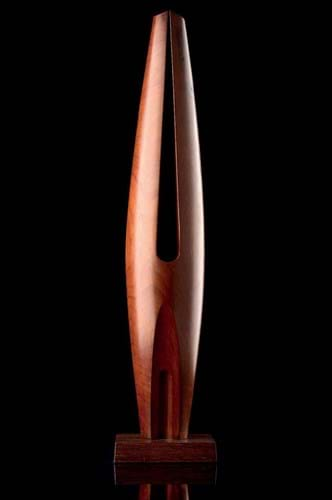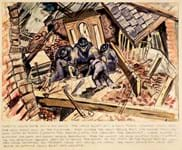Taking place during a tricky trading period for Modern British art, relative newcomer Lyon & Turnbull (25/20% buyer’s premium) got London’s autumn sales off to a bright start.
Modern Made, the firm’s second London auction focused mainly on Mod Brit art, sculpture, design and studio ceramics, took place on November 14, a week before Sotheby’s, Christie’s and Bonhams offered major sales in the capital.
This predominately domestic market has been less bullish during the UK’s challenging socio-political climate, causing some hesitation among potential consignors and buyers. However, L&T’s sale generated healthy competition among private buyers for the ‘right’ pieces, posting a high selling rate (83%) and a £470,000 hammer total.
Philip Smith, associate director at L&T and head of sale, said “most pieces made their money”, despite having concerns beforehand that the current “uncertainty” might hamper business.
The “crossover nature of the sale, offering a mix of price points and focusing people by not having too many things of one type” helped to reduce the number of unsold lots, he added.
The auction centred on a 38-lot group of sculpture and art from the zenith of the St Ives School in the mid-20th century. It came from the estate of an ‘important St Ives artist’, assumed to be the Abstract sculptor Denis Mitchell.
Several of the works were inscribed to him, including pieces by Ben Nicholson, Breon O’Casey and Barbara Hepworth (whom he worked with as an assistant between 1949-59), as well as a selection of rare material relating to Porthia Prints, a short-lived company established by Mitchell and his brother in the 1950s (see News Digest, ATG No 2418 for more on the Porthia Prints).
Frost hot lot
The financial highlight at L&T was a rare early work by Terry Frost (1915-2003) titled The Island and dated 1950. The use of muted colours in the 12in x 2ft (30 x 60.5cm) oil on canvas, which Smith described “as very strongly St Ives”, together with its market freshness appealed greatly to collectors and it was knocked down to a private buyer at £21,000, three times the estimate.
Frost spent a year in St Ives before holding his first solo show there in 1947. He continued to exhibit in the town over the years and settled there in 1951, working as an assistant to Hepworth. It was during this time that he developed and refined his distinctively vibrant, geometric abstract style, which typically involved colourful patterns of overlapping squares, rectangles and half-circles.
Breon O’Casey (1928-2011) was another British Abstract artist with a strong involvement in the St Ives School. Red Sun, a prime 1960s example of the Irish painter’s experimentation with geometric form, was taken to £13,000 by a UK-based buyer, one of the highest results achieved for an O’Casey oil.
The 2ft x 3ft (61 x 91cm) oil on canvas was estimated at £3000-5000 and inscribed To Denis Mitchel from Breon O’Casey with respect & gratitude 1965.
Another quintessential work was one by Denis Mitchell (1912-93) himself: an extensively exhibited wood sculpture, Roseveor, a sleek 23in (59cm) work carved from yew in 1985.
Showing the influence of Hepworth and the continental impact of Brancusi, it more than doubled top estimate to sell to a private buyer on the phone for £14,500. A 1968 fibreglass piece titled Carn Galver II, shown at Mitchell’s major solo show in 1979 at the Glynn Vivian Gallery in Swansea, sold within estimate at £6500.
The sale also contained 15 lots from the estate of Bryan Ingham (1936-97), who spent much of his artistic career in Cornwall, particularly the Lizard peninsula where he owned a remote cottage. He worked in a variety of mediums, creating a large body of works inspired by the likes of Ben Nicholson and Peter Lanyon, alongside the wider Continental influences of Mondrian, Braque and Picasso.
All bar one lot in the group found buyers with the stand-out lot, a 1994 abstract pencil, oil and collage titled January, tipping over top estimate to sell for £4000.
'Extraordinarily good price'
Away from artists’ estates, strong bidding emerged for a privately consigned still-life of tulips by Matthew Smith (1879-1959) with London gallery provenance. The 22 x 18in (54 x 45cm) oil on canvas, described as in ‘good overall condition’ in the catalogue note, did rather better than predicted, selling for £25,000 to a private buyer who beat competition from the trade.
“This was an extraordinarily good price, especially given the market for earlier Mod Brit works have been more considered of late,” said Smith.
More ‘considered’ bidding was in evidence for a 15 x 21in (37 x 55cm) watercolour of eggs on a table by the famous war artist Paul Nash (1889-1946), which had been in a private collection since 1994.
Belonging to a body of work in which Nash explored Abstraction and Surrealism in the early 1930s, Easter Sunday found a buyer towards the bottom guide at £7500.
One of the most admired lots was a rare painting by the potter Waistel Cooper (1921-2003) modestly estimated at £500-800. Possibly a self-portrait, the 11 x 9in (28 x 23cm) oil on board benefited from the crossover interest of studio pottery and Mod Brit collectors, selling on the day for £4200.
Multi-estimate sums were also achieved for one of Maggi Hambling’s (b.1945) larger wave oils at £9000, and a highly detailed study of cobbles from the 1970s Lorrypark Series by the so-called Boyle Family of artists made £10,000 (though the price is around half the sum such works were making 30 years ago).

















